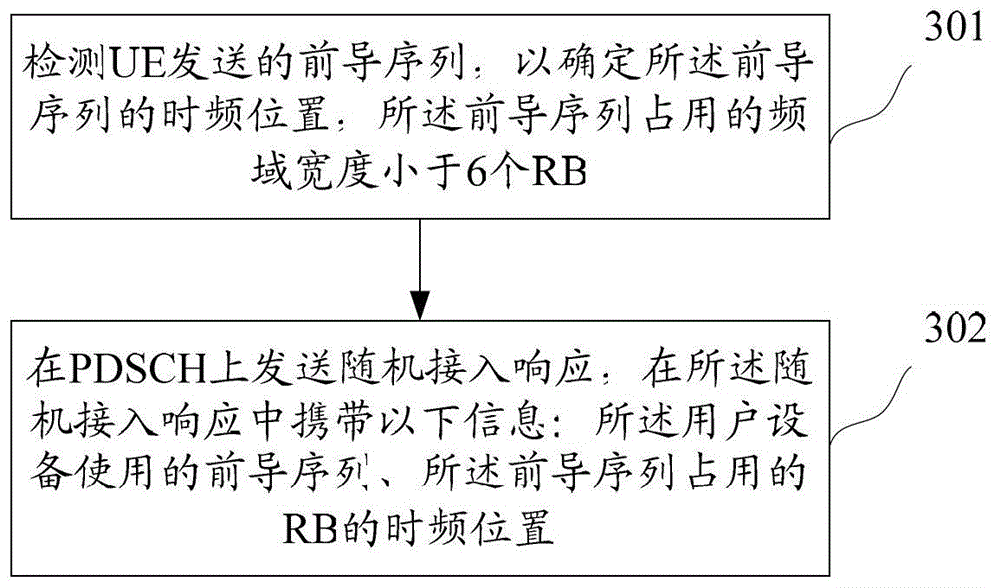Contention-based random access method and device
A random access and random access response technology, applied in the field of communication, can solve the problems of limited PRACH coverage, achieve the effects of solving limited PRACH coverage, ensuring communication quality, and enhancing coverage
- Summary
- Abstract
- Description
- Claims
- Application Information
AI Technical Summary
Problems solved by technology
Method used
Image
Examples
Embodiment 1
[0072] In this embodiment, a preamble sequence of length 139 is used.
[0073] The UE can randomly select the frequency domain width of one RB among the 6 RB frequency domain widths occupied by the existing PRACH channel for sending the preamble sequence, and different UEs can select different RB frequency domain positions. In this case, before the above step 201, the eNodeB can notify the UE of the PRACH sequences used for contention-based random access through the broadcast channel similarly to the prior art, and the UE randomly selects one of these PRACH sequences as the preamble sequence Sending, that is to say, the preamble sequence sent by the UE may be a sequence selected by the UE from the set of PRACH sequences used for contention-based random access. In this case, the UE only needs to send the preamble within one TTI. Correspondingly, before the above step 201, the eNodeB receives the preamble sequence with a length of 139 sent by the UE within one TTI.
[0074] Fu...
Embodiment 2
[0079] In this embodiment, a preamble sequence of length 839 is used.
[0080] Specifically, the preamble sequence can be divided into 6 parts, and only one RB position in the 6 RB widths is sent in the frequency domain, and only 1 / 6 part of the preamble sequence is sent in one TTI, and within six consecutive TTIs Different parts of the preambles are sent respectively, and the frequency domain positions of the RBs occupied by the preambles in these TTIs are the same. In the time domain, the duration of a preamble sequence is 6 times longer than the original one. Since 839 is not divisible by 6, in practical applications, 839 can be divided into 140*5+139, and the sequence length sent in the first 5 TTIs is 140, which is located in the middle of 144 available subcarriers in 1 RB in the frequency domain , leaving a guard band of 2 subcarriers on both sides; the sequence length sent in the latter TTI is 139, which is also located in the middle of 144 available subcarriers in 1 R...
Embodiment 3
[0087] In this embodiment, the number of available PRACH sequences or sequence templates in one cell is still kept at 64, and the UE selects and transmits the preamble sequence in a manner similar to the previous two embodiments, and will not be described in detail here.
[0088] The difference from the previous embodiment is that in this embodiment, the 6-bit RAPID parameter can no longer be used to indicate the preamble sequence used by the UE and the frequency domain position of the RB occupied by the preamble sequence in the RB set, but only Indicates the preamble used by the UE.
[0089] Specifically, after the eNodeB successfully detects the preamble sequence sent by the UE, it sends a random access response to the UE. In the random access response, the RAPID parameter is used to indicate the preamble sequence used by the UE, and the RA-RNTI parameter is used to indicate the preamble sequence used by the UE. The time and frequency domain location of the sequence. RA-RNT...
PUM
 Login to View More
Login to View More Abstract
Description
Claims
Application Information
 Login to View More
Login to View More - R&D
- Intellectual Property
- Life Sciences
- Materials
- Tech Scout
- Unparalleled Data Quality
- Higher Quality Content
- 60% Fewer Hallucinations
Browse by: Latest US Patents, China's latest patents, Technical Efficacy Thesaurus, Application Domain, Technology Topic, Popular Technical Reports.
© 2025 PatSnap. All rights reserved.Legal|Privacy policy|Modern Slavery Act Transparency Statement|Sitemap|About US| Contact US: help@patsnap.com



